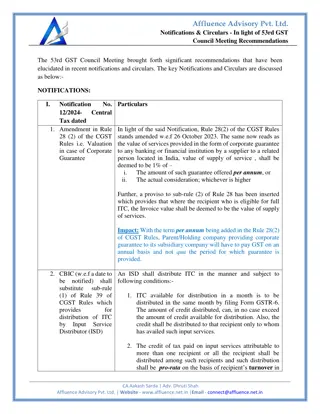
Understanding Hall Effect in Semiconductors
Explore the Hall Effect phenomenon in semiconductors, where the behavior of free charge carriers in the presence of electric and magnetic fields leads to the development of Hall voltage. Learn how to determine semiconductor type, calculate carrier concentration, and understand mobility through Hall Effect. Discover the mathematical expressions and advantages of this fundamental concept.
Download Presentation

Please find below an Image/Link to download the presentation.
The content on the website is provided AS IS for your information and personal use only. It may not be sold, licensed, or shared on other websites without obtaining consent from the author. If you encounter any issues during the download, it is possible that the publisher has removed the file from their server.
You are allowed to download the files provided on this website for personal or commercial use, subject to the condition that they are used lawfully. All files are the property of their respective owners.
The content on the website is provided AS IS for your information and personal use only. It may not be sold, licensed, or shared on other websites without obtaining consent from the author.
E N D
Presentation Transcript
Hall Effect Hall Effect describes the behavior of free charge carriers in the semiconductor when subjected to the electric and magnetic fields. It is well known that a potential applied across the semiconductor material causes the electrons within it to move in the direction opposite to that of the applied field (Figure 1a). Further, it is to be noted that, in this case, the path of the electrons will be almost a straight line.
Now, if the same material is subjected to the transverse magnetic field, the electrons start moving along the curved path as shown by (Figure 1b) due to the force exerted by the applied magnetic field on them. This leads to the increase in the number of electrons on one side of the semiconductor while the corresponding opposite side experiences electron deficiency. As a result, there is a voltage developed across these two sides of the semiconductor material. The voltage developed is called Hall Voltage (VH) and the associated phenomenon is referred to as Hall Effect.
Moreover, the direction of the developed Hall voltage will be perpendicular to both the direction of current flow as well as to the applied magnetic field. Thus, Hall Effect can be stated as the phenomenon when the current carrying conductor or semiconductor subjected to the external magnetic field develops a voltage across its terminals in the direction perpendicular to both the flow of current as well as to the direction of applied magnetic field. Mathematical expression for the Hall voltage is given by: W h e r e : I represent current flowing through the sample, B represents the strength of the magnetic field, q represents the charge, n is the number of mobile charge carriers per unit volume, d represents the thickness of the sample. Here the term 1/(qn) is called the Hall Coefficient (RH) which is negative if the majority charge carriers are electrons while positive if the majority charge carriers are holes.
Advantages of Hall effect 1-Determine the Type of Semiconductor: By knowing the direction of the Hall Voltage, one can determine that the given semiconductor or p-type semiconductor. This is because Hall coefficient (RH) is negative for n-type semiconductor while the same is positive in the case of p-type semiconductor. sample is whether n-type 2-Calculate the Carrier Concentration: The expressions for the carrier concentrations of electrons (n) and holes (p) in terms of Hall coefficient are given by:
3-Determine the Mobility (Hall Mobility): Mobility expression for the electrons ( n) and the holes ( p), expressed in terms of Hall coefficient is given by: Where: n and p represent the conductivity due to the electrons and the holes, respectively. 4-Measure Magnetic Flux Density: This equation can be readily deduced from the equation of Hall voltage and is given by:






















